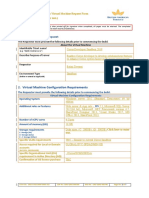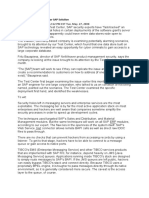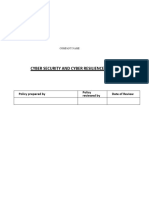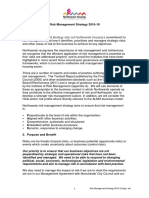0 ratings0% found this document useful (0 votes)
101 viewsNist Cyber Resilience Framework
Nist Cyber Resilience Framework
Uploaded by
siziThe NIST Cyber Resilience Framework outlines 5 functions - identification, protection, detection, response, and recovery - to improve ICT resilience. It includes categories such as asset management, governance, risk assessment, access control, data security, anomaly detection, security monitoring, response planning, and recovery planning. The framework takes a 360 degree approach to cybersecurity and resilience.
Copyright:
© All Rights Reserved
Available Formats
Download as PDF, TXT or read online from Scribd
Nist Cyber Resilience Framework
Nist Cyber Resilience Framework
Uploaded by
sizi0 ratings0% found this document useful (0 votes)
101 views1 pageThe NIST Cyber Resilience Framework outlines 5 functions - identification, protection, detection, response, and recovery - to improve ICT resilience. It includes categories such as asset management, governance, risk assessment, access control, data security, anomaly detection, security monitoring, response planning, and recovery planning. The framework takes a 360 degree approach to cybersecurity and resilience.
Original Description:
Cyber
Original Title
nist_cyber_resilience_framework
Copyright
© © All Rights Reserved
Available Formats
PDF, TXT or read online from Scribd
Share this document
Did you find this document useful?
Is this content inappropriate?
The NIST Cyber Resilience Framework outlines 5 functions - identification, protection, detection, response, and recovery - to improve ICT resilience. It includes categories such as asset management, governance, risk assessment, access control, data security, anomaly detection, security monitoring, response planning, and recovery planning. The framework takes a 360 degree approach to cybersecurity and resilience.
Copyright:
© All Rights Reserved
Available Formats
Download as PDF, TXT or read online from Scribd
Download as pdf or txt
0 ratings0% found this document useful (0 votes)
101 views1 pageNist Cyber Resilience Framework
Nist Cyber Resilience Framework
Uploaded by
siziThe NIST Cyber Resilience Framework outlines 5 functions - identification, protection, detection, response, and recovery - to improve ICT resilience. It includes categories such as asset management, governance, risk assessment, access control, data security, anomaly detection, security monitoring, response planning, and recovery planning. The framework takes a 360 degree approach to cybersecurity and resilience.
Copyright:
© All Rights Reserved
Available Formats
Download as PDF, TXT or read online from Scribd
Download as pdf or txt
You are on page 1of 1
NIST Cyber Resilience Framework zur Verbesserung der IKT-Resilienz
5 Funktionen – 360° Abdeckung für Cyber Security & Resilience
Funktionen Kategorien
Inventar Management (Assest Management) (ID.AM Geschäftsumfeld (Business Environment) (ID.BE)
Governance (ID.GV)
IDENTIFIZIEREN (ID) Risikomanagement (Risk Assessment) (ID.RA)
Risikomanagement Strategie (Risk Management Strategy) (ID.RM)
Lieferketten Risikomanagement (Supply Chain Risk Management) (ID.SC)
Zugriffsmanagement und -steuerung (Access Control) (PR.AC)
Awareness and Training (PR.AT
Datensicherheit (Data Security) (PR.DS)
SCHÜTZEN (PR)
Schutz von Daten (Information Protection Processes and Procedures) (PR.IP)
Maintenance (PR.MA)
Protective Technology (PR. PT)
Governance
Vorfälle (Anomalies and Events) (DE.AE)
ERKENNEN (DE) Überwachung (Security Continuous Monitoring) (DE.CM)
Detection Processes (DE.DP)
Response Planning (RS.RP)
Kommunikation (Communications) (RS.CO)
REAGIEREN (RS) Analyse (Analysis) (RS.AN)
Bewältigung (Mitigation) (RS.MI)
Verbesserungen (Improvements) (RS.IM)
Wiederherstellungsplanung (Recovery Planning) (RC.RP)
WIDERHERSTELLEN
Verbesserungen (Improvements) (RC.IM)
(RC)
Kommunikation (Communications) (RC.CO)
RM Risk Management AG, Security & Risk Consultants, Switzerland 2
You might also like
- Cisco Cybersecurity Essentials CourseDocument105 pagesCisco Cybersecurity Essentials CourseScribdTranslationsNo ratings yet
- CDA Guidelines For Public Safety Around Dams 2011 - Chin Kok Toh of Angkasa Consulting Services SDN BHD PDFDocument88 pagesCDA Guidelines For Public Safety Around Dams 2011 - Chin Kok Toh of Angkasa Consulting Services SDN BHD PDFkow lip fungNo ratings yet
- Health, Security, Safety and Environment (HSE)Document9 pagesHealth, Security, Safety and Environment (HSE)kaveh100% (1)
- The Cyber Crime Hall of Fame - The Phone Masters Case, by Asad SyedDocument12 pagesThe Cyber Crime Hall of Fame - The Phone Masters Case, by Asad SyedAsad SyedNo ratings yet
- SD Wan Networks Enable Digital Business EcosystemsDocument17 pagesSD Wan Networks Enable Digital Business EcosystemsHungtx TranNo ratings yet
- Crisis Management in Cruise Tourism A Case Study of DubrovnikDocument16 pagesCrisis Management in Cruise Tourism A Case Study of DubrovnikAleksandarNo ratings yet
- Security Through Diversity: MASTER - Advanced Techniques For Information ProcessingDocument26 pagesSecurity Through Diversity: MASTER - Advanced Techniques For Information ProcessingCorneliu DincaNo ratings yet
- IPD - Malware ResponseDocument55 pagesIPD - Malware ResponseAndy UrbanNo ratings yet
- CNS Sem5 CBCS Inft Engg May19Document1 pageCNS Sem5 CBCS Inft Engg May19gbhggg81No ratings yet
- Forensics Assignment (Main)Document31 pagesForensics Assignment (Main)Mohammad Raf'atiNo ratings yet
- Data Center SecurityDocument6 pagesData Center SecurityToby NixonNo ratings yet
- Information Technology Act, 2000: Cyber LawsDocument13 pagesInformation Technology Act, 2000: Cyber LawsHeena TejwaniNo ratings yet
- Privacy and The InternetDocument14 pagesPrivacy and The InternetNaomi L. Baker PetersonNo ratings yet
- Cirrus - VM Request Form v2Document7 pagesCirrus - VM Request Form v2R velayudNo ratings yet
- 04 Compter HardwareDocument12 pages04 Compter HardwareragulanNo ratings yet
- Computer Fundamentals FinalDocument15 pagesComputer Fundamentals FinalanilperfectNo ratings yet
- Hacking Into A Billion-Dollar SAP Solution by Mario Morejon, CRN 12:12 PM EST Tue. May. 27, 2008Document14 pagesHacking Into A Billion-Dollar SAP Solution by Mario Morejon, CRN 12:12 PM EST Tue. May. 27, 2008onubeyNo ratings yet
- Snort Installation PDFDocument21 pagesSnort Installation PDFshubhangiNo ratings yet
- E-Commerce: Digital Markets, Digital GoodsDocument22 pagesE-Commerce: Digital Markets, Digital GoodsjamisssNo ratings yet
- Microsoft WindowsDocument13 pagesMicrosoft Windowsseety2No ratings yet
- Ernieexample2 PDFDocument117 pagesErnieexample2 PDFkksunNo ratings yet
- Cybersecurity ProgramDocument8 pagesCybersecurity Programapi-522484422No ratings yet
- BitLocker Drive Encryption StepDocument14 pagesBitLocker Drive Encryption StepXianming ChongNo ratings yet
- PCI ComplianceDocument773 pagesPCI CompliancegsurivNo ratings yet
- Smart Cards: Presented by Jishnu Sasikumar Reg No: 09 PG 142Document13 pagesSmart Cards: Presented by Jishnu Sasikumar Reg No: 09 PG 142jishnu_2025No ratings yet
- 123 Key Steps For An Effective Iso 27001 Risk Assessment and TreatmentDocument4 pages123 Key Steps For An Effective Iso 27001 Risk Assessment and Treatmentshiva kumarNo ratings yet
- Career Path Syllabus - SOC Analyst Level 1Document3 pagesCareer Path Syllabus - SOC Analyst Level 1Muhammad IbrahimNo ratings yet
- Fundamentals of Dbms and OracleDocument122 pagesFundamentals of Dbms and OracleYashveer MachraNo ratings yet
- 6 OS - PPT Compatibility ModeDocument33 pages6 OS - PPT Compatibility ModeBagus FatkhurroziNo ratings yet
- AWS CJIS Policy Requirements PDFDocument82 pagesAWS CJIS Policy Requirements PDFSpit FireNo ratings yet
- ATTaCKing Threat Management A Structured Methodology For Cyber Threat AnalysisDocument30 pagesATTaCKing Threat Management A Structured Methodology For Cyber Threat Analysisdimos katerinaNo ratings yet
- Certified Ethical Hacker Ceh Crash CourseDocument2 pagesCertified Ethical Hacker Ceh Crash CourseJory MontoyaNo ratings yet
- Ip Unit 2Document51 pagesIp Unit 2iyyanarappan aNo ratings yet
- Nessus ProfessionalDocument2 pagesNessus ProfessionalKishore Chowdary SNSNo ratings yet
- 31 Popular Linux DistributionsDocument22 pages31 Popular Linux DistributionsMaserati. MTNo ratings yet
- Automatic Port ScannerDocument7 pagesAutomatic Port ScannerInternational Journal of Innovative Science and Research TechnologyNo ratings yet
- Data CollectionDocument44 pagesData Collection282030 ktr.pg.iscf.18No ratings yet
- Creating A Web App From ScratchDocument92 pagesCreating A Web App From ScratchRobert Ștefan StănescuNo ratings yet
- Overkill Security. Digest. 2024-05. Level#ProDocument67 pagesOverkill Security. Digest. 2024-05. Level#ProOverkill SecurityNo ratings yet
- What Is A Remote Desktop ConnectionDocument5 pagesWhat Is A Remote Desktop ConnectioncolleebNo ratings yet
- Questio S Answers of DBM SDocument13 pagesQuestio S Answers of DBM SJeetu SinghNo ratings yet
- Intrusion Detection System Based On The Analysis of Time Intervals of CAN Messages For In-Vehicle NetworkDocument6 pagesIntrusion Detection System Based On The Analysis of Time Intervals of CAN Messages For In-Vehicle NetworkPaulNo ratings yet
- Cyber Security Incident Report: Electronic PhysicalDocument1 pageCyber Security Incident Report: Electronic Physicalmuhammadamir1No ratings yet
- Internet of Things (Iot) : A Survey On Architecture, Enabling Technologies, Applications and ChallengesDocument12 pagesInternet of Things (Iot) : A Survey On Architecture, Enabling Technologies, Applications and ChallengesayadmanNo ratings yet
- AcknowledgementDocument19 pagesAcknowledgementFaraz AbbasNo ratings yet
- Self-Attention GRU Networks For Fake Job ClassificationDocument5 pagesSelf-Attention GRU Networks For Fake Job ClassificationInternational Journal of Innovative Science and Research TechnologyNo ratings yet
- Enterprise Architecture Landscape Using TOGAF Framework For Offshore CompanyDocument11 pagesEnterprise Architecture Landscape Using TOGAF Framework For Offshore CompanyEdd AguaNo ratings yet
- RedTech30 AEC Case StudyDocument3 pagesRedTech30 AEC Case StudySumitNo ratings yet
- A System For Keyword-Based Searching in Databases: N.L. Sarda Ankur JainDocument18 pagesA System For Keyword-Based Searching in Databases: N.L. Sarda Ankur JainSomasundaram SekarNo ratings yet
- VERITY BrochureDocument6 pagesVERITY BrochureRatkoMRNo ratings yet
- Presentation DNA CryptographyDocument29 pagesPresentation DNA Cryptographycool_duke88No ratings yet
- How Does A Disaster Recovery (DR) Plan Work?Document12 pagesHow Does A Disaster Recovery (DR) Plan Work?tricia quilangNo ratings yet
- Hardware Grade 09 TLE Module PDFDocument133 pagesHardware Grade 09 TLE Module PDFWil-Ly de la CernaNo ratings yet
- Linux Installation - MergedDocument109 pagesLinux Installation - MergedTamero KaNo ratings yet
- Java PointDocument21 pagesJava PointCricket Officials VidoesNo ratings yet
- MC Lecture NotesDocument101 pagesMC Lecture NotesMallesh ArjaNo ratings yet
- Bn303 Wireless Network & SecurityDocument16 pagesBn303 Wireless Network & SecurityMitali BiswasNo ratings yet
- Operating SystemDocument57 pagesOperating SystemNitika SahNo ratings yet
- CYBER POLICY Version1 - 1Document14 pagesCYBER POLICY Version1 - 1deeptanwar1997No ratings yet
- Information Security Policy A Complete Guide - 2019 EditionFrom EverandInformation Security Policy A Complete Guide - 2019 EditionNo ratings yet
- REMOTE ACCESS VPN- SSL VPN: A deep dive into SSL VPN from basicFrom EverandREMOTE ACCESS VPN- SSL VPN: A deep dive into SSL VPN from basicRating: 5 out of 5 stars5/5 (1)
- RSA Archer Policy Management: Build Your Governance, Risk and Compliance Program On A Firm FoundationDocument2 pagesRSA Archer Policy Management: Build Your Governance, Risk and Compliance Program On A Firm Foundationnmukherjee20No ratings yet
- ChangesDocument56 pagesChangesAbdullatif Al NajimNo ratings yet
- James Whyte CV May 2018Document2 pagesJames Whyte CV May 2018James WhyteNo ratings yet
- TSC Tbl1plus Rams Pha DRAFTDocument18 pagesTSC Tbl1plus Rams Pha DRAFTMarocain DbxNo ratings yet
- 2.0 Samplef of Hseq ManualDocument27 pages2.0 Samplef of Hseq ManualSơn Nguyễn Thái100% (1)
- U4.3 Earthquakes WS SDocument2 pagesU4.3 Earthquakes WS Spe0297yNo ratings yet
- Chapter 11 12Document32 pagesChapter 11 12Aphrobit CloNo ratings yet
- ITA Report N2 WG19 P PDFDocument28 pagesITA Report N2 WG19 P PDFBikaZeeNo ratings yet
- Calyptra: Jurnal Ilmiah Mahasiswa Universitas Surabaya Vol.2 No.2 (2013)Document16 pagesCalyptra: Jurnal Ilmiah Mahasiswa Universitas Surabaya Vol.2 No.2 (2013)shidqi amartyaNo ratings yet
- Pipeline Risk Management Basic ManualDocument6 pagesPipeline Risk Management Basic ManualhemnNo ratings yet
- ASP10 BlueprintDocument4 pagesASP10 Blueprintgeologistlakhan100% (1)
- Auto Finance Manager ResumeDocument4 pagesAuto Finance Manager Resumeafmrqifopkokdt100% (1)
- Earthquake Drill MemorandumDocument11 pagesEarthquake Drill MemorandumHil Sayo Lpt100% (1)
- Location of Gujarat in India Figure 1-1. Location of TheDocument4 pagesLocation of Gujarat in India Figure 1-1. Location of TheRuchir KainNo ratings yet
- Risk Management Strategy 2016 18Document11 pagesRisk Management Strategy 2016 18MohamedSaidNo ratings yet
- Case Study 2 - TescoDocument1 pageCase Study 2 - TescoEslam IsmailNo ratings yet
- Critical Incident ReportingDocument44 pagesCritical Incident Reportingsushil@irdNo ratings yet
- ABB AutomationDocument0 pagesABB AutomationNelson P. ColoNo ratings yet
- ROLES AND FUNCTIONS OF SCHOOL DRRM COMMITTEEs 2019-2020Document8 pagesROLES AND FUNCTIONS OF SCHOOL DRRM COMMITTEEs 2019-2020marra dealaNo ratings yet
- Business Risk & Controls SR As Description at Wells FargoDocument7 pagesBusiness Risk & Controls SR As Description at Wells Fargoc sekarNo ratings yet
- DRRR 11 - 12 Q1 0201 Vulnerability PSDocument20 pagesDRRR 11 - 12 Q1 0201 Vulnerability PSHurry Delacruz BayonaNo ratings yet
- Certification BodiesDocument259 pagesCertification BodiesSadaf RaqeebNo ratings yet
- Dissertation - Credit Risk Management Priority, Case Study of Russian BankingDocument32 pagesDissertation - Credit Risk Management Priority, Case Study of Russian Bankingthemany2292No ratings yet
- Risk Management in Software ProjectsDocument4 pagesRisk Management in Software ProjectsHimanshu BhansaliNo ratings yet
- Journal of Natural Gas Science and EngineeringDocument10 pagesJournal of Natural Gas Science and EngineeringJude OkoyeNo ratings yet
- Group Members: - Opio Isaac - Eritu Pius - Masika Noerine - Nalwasa Eria - Bua EmmanuelDocument16 pagesGroup Members: - Opio Isaac - Eritu Pius - Masika Noerine - Nalwasa Eria - Bua EmmanuelEria NalwasaNo ratings yet
- Chapter 3 Software Project Management - Part1Document20 pagesChapter 3 Software Project Management - Part1Sanjoy GhatakNo ratings yet

























































































